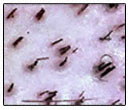Follicular Unit Hair Transplantation used to be the "gold standard" in hair restoration surgery and was worlds ahead of the older hair transplant procedures still performed by some of today's surgeons.
Today, the preferred method for most patients is the Follicular Unit Extraction (FUE) method. However, FUT still has its place in the surgical hair restoration industry. Contrary to popular belief, FUT is not outdated or irrelevant but is no longer considered the gold standard in modern surgical hair restoration.
To understand why the results of this hair transplant procedure look so natural, you must first understand how hair grows.
How hair grows naturally on the scalp.
 If you look closely at naturally growing hair using magnification you will see that hair actually grows in groupings of one, two, three, and four hairs.
If you look closely at naturally growing hair using magnification you will see that hair actually grows in groupings of one, two, three, and four hairs.
These naturally occurring hair groupings grow in irregular patterns on the scalp, similar to how grass grows on a lawn. These groupings are technically referred to as "follicular units."
Natural hair transplantation results come from copying nature, hair for hair.
By relocating these carefully prepared bald-resistant follicular units from the back and sides of the scalp, physicians doing "follicular unit hair transplantation" recreate a natural pattern of hair in the balding areas.
To do this properly is a very time-consuming process. It requires a team of skilled and meticulous medical technicians working closely with the hair transplant surgeon.
Advantages of a Follicular Unit Hair Transplantation over standard procedures:
 Smaller grafts with minimal incisions.
Smaller grafts with minimal incisions.
Carefully prepared follicular unit grafts to contain a minimum of excess scalp tissue and are very tiny, compact structures. As a result, the grafts fit into tiny incisions that produce very little trauma to the scalp.
The use of smaller grafts with less invasive incisions permits a larger number of grafts to be transplanted in one session. In addition, the small grafts can be placed closer together.

Careful trimming of the donor tissue using microscopes produces more grafts.
By carefully trimming donor tissue into the naturally occurring follicular units under magnification (using high-powered microscopes), the maximum number of intact and undamaged grafts are produced from a given amount of donor tissue. And since a patient's donor tissue is limited, the balding patient can ultimately achieve the fullest coverage possible.
Hair Transplant Videos
How FUE (Follicular Unit Excision)and FUT differ.
How Follicular Unit Transplant (FUT)is performed.
A Follicular Unit Hair Transplantation looks natural, even on close examination.
Because the follicular unit hair transplant procedure replicates hair for hair, the way hair grows naturally produces natural results - even under close inspection.
The follicular unit hair transplant looks natural after only one surgical session. Additional procedures are only needed to increase the density of the hair transplant or to address additional areas of balding if the hair loss progresses.
This is in stark contrast to mini-micrograft procedures, where one session will generally not "stand on its own," Additional surgical sessions are required to refine or soften the appearance of the previous hair transplants.
Recent advances and refinements in follicular unit grafting -
"Ultra Refined Follicular Unit Hair Transplantation."
 While the standard micro "follicular unit" hair transplant does produce natural-looking results, its ability to achieve high density in only one surgical session is limited. Thus patients may have to do subsequent surgical sessions in a transplanted area to achieve a full look.
While the standard micro "follicular unit" hair transplant does produce natural-looking results, its ability to achieve high density in only one surgical session is limited. Thus patients may have to do subsequent surgical sessions in a transplanted area to achieve a full look.
However, leading hair transplant surgeons have evolved this follicular unit procedure into a highly refined, minimally invasive procedure that enables the follicular unit grafts to be placed very close together. This new "ultra refined" procedure enables patients to achieve cosmetic density in a given area in one surgical session while experiencing rapid healing.
Respecting the Follicular Unit
Each follicular unit is surrounded by small glands, blood vessels, nerves, and a connective tissue sac, making it a tiny self-contained unit.
If these follicular units are damaged during removal or dissection, the hair may grow poorly.
Therefore, it is important to cut only in the loose tissue between the follicular units to keep each follicular unit intact and avoid damaging it.
Find a quality hair transplant surgeon in your area
While follicular unit hair transplantation can yield optimal results for a patient, it must be performed by experienced and skilled staff.
Click the link to locate a prescreened hair transplant surgeon in your area who is dedicated to performing follicular unit hair transplantation.
















